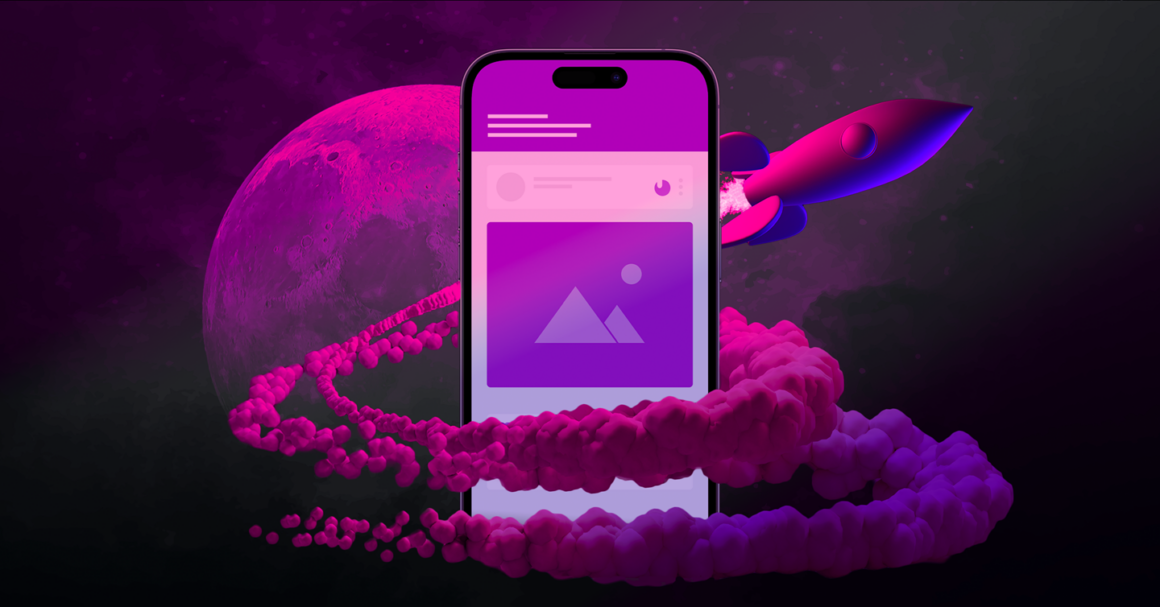No matter if your app will transform the world as we know it for everyone or simply make the life of its 100 users one percent easier, you need a good app advertising strategy for it to make any impact.
Strategies for advertising apps are not that much different from those for advertising other offers or products. The key ingredients are still there, but with some notable differences, plus an addition of some new flavours.
So let’s not waste any more of your precious time and let’s see what you can do to get your app advertising campaign off the ground.
Direction: Moon and beyond.
1. Advertise for all parts of the campaign funnel
If there’s only one piece of information you should remember from this article, this would be it:
“Take care of users at each step of a marketing journey.”
Your prospect app users go through various parts of a typical advertising funnel at their own pace. You should address it by running separate campaigns with messaging tailored for each stage:
1. Awareness
People on this stage know nothing about you, your app, and what it can do. You can launch brand-oriented campaigns to make your brand more recognizable, you can talk about certain problems that your app can resolve.
There’s nothing wrong with building up the tension using the “Something big is coming” approach. However, you should be sure that your app delivers on at least some of the promises.
To sum up, you should introduce yourself to your audience and tell them what you plan to do. Don’t aim for app installs just yet. Even if your app is already launched, people on this stage rarely convert. However, they are ready for the second stage.
2. Interest or engagement
This is the part when you warm your audience and show off your product. You can do this by providing
- Educational content
- Reviews
Both videos and blog articles will work great with this type of content.
App installs are still not your priority – although they may happen.
3. Conversion
This is the part where you aim to increase the number of installs. You have several types of ads at your disposal:
- App install ads. These ads allow users to install an app directly after clicking the ad. These ads usually convert great as there are no unnecessary clicks in the middle.
- Lead ads. These are aimed to gather leads, so contact information such as email address. You can use these leads to send app install links or onboarding materials.
- In-app ads. These ads use deep linking to guide to the specific places in your app.
4. Retention
You thought your work was over after the conversion part? Far from that. No matter if your app is free to use, uses one-time payments or a subscription model, your goal will always be to increase user’s engagement with your app.
Churn – the percentage of users that ditch the app every month – is a phenomena that can and should be addressed.
There’s a lot of things you can do:
- Give out loyalty points.
- Launch competitions, activity rankings.
- Propose discounts for long-term users.
- Build relationships with your users outside the app: on a blog or social media channels.
2. Plan ahead
Doing anything else apart from curating your precious app weeks before the launch is asking for a lot, I know. But you simply have to find some time to launch a preemptive campaign. As we’ve discussed above, you have to think about users on different steps of the buyer’s journey. For some, this journey may start before the app launch.
The second thing to consider is that your launch may be postponed if your app encounters problems during the verification process in the app store. Don’t rely heavily on one date, take the “When it’s ready” approach.
3. Create personas
This sounds like boring excerpts from a marketing textbook but trust me. Your app may be used in different ways by people with different motivations. Advertise for them separately.
Take any ecommerce app. It is suited both for sellers and buyers. You may choose to advertise this app using universal approach with a slogan like:
“The best place to trade goodies online”
OR
You can create buyer and seller personas. If this is mainly for individuals getting rid of old clothes for some petty cash, you can create a more personal message:
For sellers: “Give your old clothes a second life and earn a little extra with our app.”
For buyers: “Truly vintage and unique clothing available for as cheap as a cup of coffee.”
Try to target these messages to concrete audiences. Sellers and buyers may be gathered in specific groups on Facebook or be present on different publisher’s sites.
4. Choose the right ad format
Although online marketing has for years been synonymous with banner ads, know that there are other options.
A smart app advertising strategy should include ad formats that perform best with app ads.
Native ads
Native advertising provides several benefits for app advertisers:
- It allows to display ads in relevant context
- It provides plenty of space to advertise your app
- It emanates trust and confidence, unlike banner or push ads
It’s a shame that not that many people consider native ads a good place to promote their apps.
Mobile ads
One of the best ways to advertise your app is withing another app. The context matches, so in a sense, mobile ads are similar to native ads because they seamlessly blend with its surroundings. You can get mobile traffic from networks such as Smaato, Pubnative and SmartyAsa.
Display and push
Any form of display advertising (banners, pop-ups or pop-unders, interstitials) are great way to advertise an app that relies on emotions. A good example are dating apps. Push ads make themselves visible at a given point in time and are usually associated with alerts and deal occasions, so you can advertise relevant apps using this format.
5. Track app installs, ads, and user activities
Insights about your audience is the whole reason you go through the hurdles of setting up tracking.
Did I say hurdles? With Voluum, setting up tracking takes almost no time at all. You set it up by adding elements such as offers, landing pages and traffic sources and then define traffic flow in a campaign. You just have to also select one of the conversion tracking methods: S2S postback URL, conversion tracking pixel, or API integration.
As simple as that.
With a help of an MMP (mobile measurement partner such as AppsFlyer), you can also track in-app events and pass them to Voluum. This way you will connect all your advertising efforts in one place – Voluum.
6. Take care of App Store Optimization (ASO)
We all know and love (kinda) SEO but meet its younger sibling: ASO. What this term describes is the effort of making your app more discoverable in the app store.
According to research, 70% of apps are discovered through internal search. To get a top position, make sure that you prepare:
- Description with relevant keywords that advertises the app’s main benefits and lists the rewards it has won.
- Visuals, like screenshots with a description and app icon that is clearly distinguishable in the crowd. Use distinct colors, avoid using soft pastel colors.
- App name that should either contain keywords (for example, “Help sleeping app”), describe app’s main function (“Sleeper”), or a catchy name that is unrelated to its function but promoted enough to be recognizable.
- You can also provide a short subtitle for your app’s name. It’s hard to tell how big of a role a subtitle plays in the discoverability. Maybe not at all. But once your app is discovered, the short yet precise subtitle may tip the scale towards installing your app.
7. Employ influencers
If I had a dollar for every time the video contains the words “This video is sponsored by Skillshare”, I would probably own Skillshare.
People sometimes put an unreasonable amount of trust into people they know from social media. This trust extends also to things they recommend. Reach out to youtubers or influencers on other media to discuss promoting your app.
8. Create a referral program
There are few marketers that are more dedicated than the people that already tried and liked your app. Create a referral program and reward existing users for bringing new users.
Use Voluum to track your referral program and the performance of each of your user-turned-marketers.
You can reward them with cash or in-app bonuses, your choice. Once you build a whole network of affiliates, your marketing is basically working by itself.
Many app advertising strategies for many apps
There are various kinds of apps with different business models implemented in them. Maybe not everything that we have mentioned here will work for you. But surely something will.
Are you excited? You should be! Advertising apps is fun: you get a whole new playground for your ideas – your app.
You have a great way of rewarding people for their engagement. Gamification is the way to go.
You know what else is a way to go?
Voluum.
Why keep guessing what works and why work in blind when you can have all data ready to analyze in a trusted tracker?
I have no idea why.



